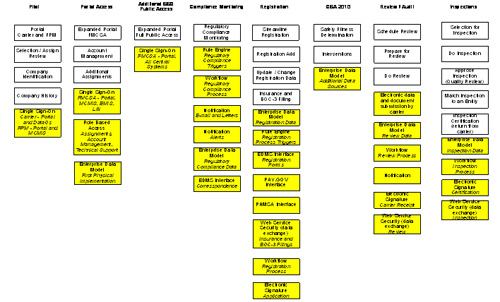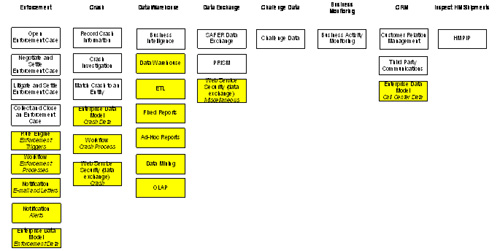What is COMPASS?
COMPASS stands for “Creating Opportunities, Methods and Practices to Secure Safety.” It is a 5-year, $130 million process improvement and legacy system modernization program for the Federal Motor Carrier Safety Administration (FMCSA). FMCSA was established as a separate administration within the federal Department of Transportation in early 2000 pursuant to the Motor Carrier Safety Improvement Act of 1999. As FMCSA was established many legacy systems from the Federal Highway Administration (FHWA) were moved from FHWA to FMCSA.
FMCSA performed an architectural review of the new organization and found that business processes and systems need to be integrated and modernized in order to fulfill its mission. An RFP was issued for a vendor to manage the COMPASS program and an award was made to a prime contractor in October 2005.
Can you clarify the scope and mission of the COMPASS program?
FMCSA’s primary mission is to reduce crashes, injuries, and fatalities involving large trucks and buses. Every 16 minutes a person is killed or sustains injuries in accidents involving 18-wheelers, tractor-trailers or semi-trucks. For example in 2001 over 429,000 large trucks were involved in traffic accidents. Over 5,000 people died and 131,000 people were injured.
FMCSA is working hard to reduce these numbers and make our highways safer. To do this there are a number of programs supported by a large variety of systems. For example FMCSA develops and enforces rules and regulations related to motor carrier safety. These rules span drivers, vehicles and companies and FMCSA provides information, compliance and enforcement services to the public. In addition, FMCSA works with state and local governments in the licensing and reporting of important federal highway safety information. Additional programs include:
• Providing online safety information, including snapshots of company (carrier) safety records;• Providing online information regarding bus and passenger safety;• Providing online opportunities for individuals to report safety violations;• Providing hazardous materials safety and security reporting, risk assessments and carrier guidelines; and• Providing safety kits and training for skill and performance criteria, cargo securement, and drug and alcohol programs.
COMPASS was initiated by FMCSA to transform the way it does business by integrating the agency’s information technologies with its business processes. Business process improvement involves integrating and extending the support systems of these programs.
How will COMPASS meet these objectives?
The COMPASS program has worked with the FMCSA to develop a target business and technical architecture that is flexible, robust and scalable in order to respond to evolving business requirements, expand information technology (IT) delivery capabilities, and reduce IT operations and maintenance costs. The amount of change is significant. To reduce risk and deliver value sooner we have decided to break the program down into a number of releases using incremental, iterative techniques.
We have created a road map which will take FMCSA from its current state to the target architecture over a five year period. This road map is the blue print that identifies the functionality, architectural components and data model elements needed for each release. The road map describes the migration of current “stove pipe” systems that have redundant data through a consolidation into one solid enterprise database that sits within a service oriented architecture (SOA) infrastructure. The SOA infrastructure consolidates applications that conduct business processes of agency into a single portal infrastructure. The road map also provides an assessment of the impact that each release will have on existing systems, and provides a description of the interdependencies with other efforts and support requirements. Finally there is a description of risks and risk mitigation strategies associated with each release.
Can you describe some of the business process elements of the road map?
The development of the COMPASS program road map was a collaboration between the Business Process Analysis Team (now called Business Requirements – BR team), a Data Quality Team, FMCSA domain experts, existing system providers and the Prime COMPASS vendor. The team reviewed the work of previous efforts that laid the foundation for areas of improvement, core business processes, and data quality issues. They examined all of the data that are currently being collected by FMCSA and determined what should and should not be collected in the future. They also set the data quality standards for data collection and reviewed improvement opportunities and regulatory requirements. This analysis was used to identify the business processes which need to be in scope of the COMPASS program, along with a prioritization of those requirements.
Once the scope of business processes was determined the team identified architecture components that need to be in place to support these processes (i.e. the target architecture). We used Zachman to guide the enterprise architecture framework, consistent with the Office of Management and Budget (OMB) Federal Enterprise Architecture Framework (FEAF). This framework provides a model of the data, process and technology elements at varying levels of detail based upon the perspective of key stakeholders. The COMPASS road map overlays this framework by identifying functionality, capabilities, tools and an enterprise data model for each release over the five year life of the program.
What does the road map look like?
There are 16 releases envisioned for the transition from the current to the future state (figures 1 & 2 below). The white boxes indicate business processes and yellow boxes indicate architecture components required to be in place.

Figure 1: Release 1-8

Figure 2: Release 9-16
How are data elements being handled?
Data migration is performed in a similar manner to the releases. As business functionality is moved to COMPASS the transactional data associated with the process is moved to the enterprise database. The first step is developing a high-level conceptual model of FMCSA data. The conceptual model identifies entities, but not their attributes, yet defines the full scope of data. The next step is to decompose the entities into logical data models (3rd normal form), and finally into an implementation or physical model for each type of data. The historic data stored in existing systems is mapped and migrated into the enterprise data base.
To do this we have to create a Common Information Model (CIM) along with maps from the data source systems. The CIM contains the business definitions of all data, creating a single semantic model. This can be a real challenge as several source systems attach different meanings to the same descriptive acronyms. For example items as basic as a “carrier” may mean a “company” in one system and a field name in another.
Can you describe the COMPASS approach to service oriented architecture (SOA)?
The COMPASS target architecture is a SOA. This framework allows the assembly of components and services for rapid delivery of solutions. All functions are defined as independent services with well-defined invokable interfaces which can be called in a defined sequence to form business processes.
Requirements are analyzed with each release on the road map. During the design phase the individual services are defined. Services must have business value and are prioritized. The goal is to design services that not only meet the needs of the current business process but can be expanded and reused in the future for similar processes.
Are there any standards which will be developed? Who will use them? How will they be used?
Yes, FMCSA is promulgating various standards relating to the collection and reporting of information on a national level. Most people think of data standards – i.e. data definitions, dictionaries, etc. Today that means structured data such as XML. We’re taking it beyond just the data to process and service definitions.
First process. The quality of information is based upon the data that is collected, and the quality of that data is based upon the processes used to collect it. We need to have standard processes for collecting data from various sources across the country in order to ensure data quality is consistent at the Federal / FMCSA level.
The second set of standards has to do with SOA. We want to have consistent service definitions and interfaces in order to be able to leverage reusability of functionality. This extends traditional data standards to include technologies, such as web services (SOAP, XML) and more specifically WSDL’s which define service components.
By extending standards to include data, process and service definitions we are able to ensure the quality of information captured and reusability of technology on a national basis.
What types of technologies and tools do you envision being used?
There are a wide variety of technologies and tools being used by COMPASS. These range from simple modeling and office tools to very complex and sophisticated integration middleware. Portal infrastructure, security and identity management infrastructure is required very early in the program. This provides a common user experience and role based security model. Integration middleware allows us to leverage existing system assets with new capabilities developed by COMPASS as the program progresses.
From there we build business process management (BPMS) and work flow capabilities, augmented by business rules management systems (BRMS). These provide the tools for more effective and efficient business processes. There are many regulations and polices which can change fairly dynamically. BRMS provide a robust and flexible platform that can support rule changes while reducing the total cost of supporting the systems. COMPASS integrates business processes (the flow of work) with the rules that govern transactions through the integration of BPMS and BRMS systems. By implementing this new architecture, we reduce the impact of rule changes on the old existing systems which coupled business rules with data and presentation.
Integrated BPMS / BRMS also allow FMCSA to monitor activity that occurs on an individual company’s records to determine if action needs to be taken. An example of this is business process assessment and optimization activities that may include: the assessment of the current compliance monitoring environment, definition of business rules, updates to policies, procedures, and roles related to compliance monitoring, and documenting the process rules to govern the development of the workflow. The business rules identify triggers when actions either occur or fail to occur that trigger various processes to suspend or revoke registration or operating authority.
Throughout the program there are numerous requirements for data extraction, transformation and load (ETL), data integration and business intelligence (BI) capabilities. It is through the integration of data that effective policy and decision making happens.
Any lessons learned, challenges or advise you would like to offer?
Organization change management is critical. COMPASS has a dedicated organizational change management team that is involved in developing an impact analysis of the strategic objectives of the each release and plans for the training of appropriate people. The change management team also works closely with the communications team to ensure that people are informed throughout the process and prepared for the implementation change. This implementation strategy must be carefully planned to ensure that changes are adopted by everyone affected.
Thank you very much Erik, we truly appreciate your time and willingness to explain this important program.

















